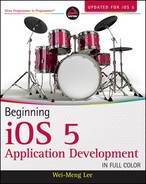SUMMARY
This chapter provided a brief introduction to the SQLite3 database used in the iPhone. With SQLite3, you can now store all your structured data in an efficient manner and perform complex aggregations on your data. To learn more about SQLite, visit its official page at www.sqlite.org.
EXERCISES
- Explain the difference between the sqlite3_exec() function and the three functions sqlite3_prepare(), sqlite3_step(), and sqlite3_finalize().
- How do you obtain a C-style string from an NSString object?
- Write the code segment to retrieve a set of rows from a table.
Answers to the exercises can be found in Appendix D.
![]() WHAT YOU LEARNED IN THIS CHAPTER
WHAT YOU LEARNED IN THIS CHAPTER
..................Content has been hidden....................
You can't read the all page of ebook, please click here login for view all page.
